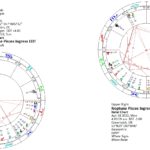The United States just had its 20th Jupiter Return on August 6, 2013! This astrological transit occurs every 12 years when Jupiter returns to its natal place in a horoscope. Western astrology determines the exact moment of a Jupiter Return and casts a chart for the “birth” of this event. Please keep in mind that I am not referring to the seasonal tropical “zodiac” system used by most western astrologers; instead I am referring to the sidereal zodiac of the stars used in traditional Vedic astrology. As in this case, I often apply certain techniques in use by western tropical astrology to the sidereal zodiac chart. The Jupiter Return chart can give a snapshot of the next 12 years relative to Jupiter’s developmental effects. What might some of these effects be?
Well, Jupiter is the lord of dharma per Vedic astrology, so is a very important planet in regard to the harmonious functioning of our world, as seen through an individual chart or the chart of a nation or group (mundane charts). The Jupiter Return chart can track how values and beliefs are shifting, and will show something about educational, spiritual, financial and social progress. It will reveal the measure of positive energy we have to work with in the coming 12 years, as well as where and how to access it. In a mundane chart, it will help us gain a deeper perspective on societal transformation, including economic, cultural, spiritual or religious trends as they evolve through each 12-year cycle.
To my knowledge, Jupiter Return as a transit technique for individual charts has not been mentioned in the conventional popular texts of Vedic astrology. However, the yearly passage of Jupiter into a new sign is used in mundane astrology forecasting through the panchanga. One Jovian year is called a samvatsara and there are 60 all total, so the full cycle repeats every 60 years. Each one has a unique essence and a particular name.
I asked a learned Vedic astrologer friend and colleague about the Jupiter Return as a transit technique. His name is Ashutosh Indoria from Rajasthan, India. He agreed with me that this is not mentioned in the Vedic astrology classics, but that it is a topic of vernacular writing in India. He also discussed with me that it is referred to in religious literature and also is used in timing certain Hindu rites of passage.
For instance, the janeyu sanskar (sacred thread ceremony) performed for boys is completed near the first Jupiter return. The second Jupiter Return traditionally marks the ending of brahmcharya and beginning of grihasth ashram, the married life. The fifth Jupiter Return coincides with the second Saturn Return around age 60 and is commemorated with a spiritual ceremony called shasti poorthi. This age marks the movement into the second half of life, typically considered to be a more spiritually oriented half.
In addition, in a similar vein, the Kumbha Mela, a large religious festival in India, is based around mundane Jupiter Returns known as ingresses, which mark the entry of transiting Jupiter into a new rashi (constellation). They are as follows:
1. Haridwar Kumbha – when Jupiter enters Aquarius (Kumbha Rashi). This is the actual Kumbha.
2. Allahabad Kumbh – When Jupiter enters Taurus (Vrishabha).
3. Nasik Kumbh – When Jupiter enters Leo (Simha).
4. Ujjain Kumbh – When Jupiter enters Scorpio (Vrishchika).
Regarding the use of Jupiter Return as a dynamic technique, I agree with my friend Ashutosh’s astute statement that “Astrology is a constant study and each observation by each astrologer, whether in past, present or future, is as important as any other. In today’s fast-changing world, we nouveau age astrologers have to continue our observations and studies to benefit the next generation of astrologers.” Simply put, as neo-Vedic astrologers, we use what works.
We analyze the Jupiter Return chart for individuals as well as for nations and groups. In regard to the latter, I am analyzing the United States Jupiter Return here. I use the James Kelleher birth chart for the United States and here am using whole-sign charts (rashi chakras) in wheel format based on Lahiri Ayanamsha, i.e., in the sidereal zodiac which I use exclusively. Below, I have posted dual wheels for the previous Jupiter Return on August 26, 2001, and the current one that began last week on August 6, 2013.
The last Jupiter Return chart occurred two weeks before 9/11. It helped set the stage for the tragic game-changing event of 9/11 as well as the post-9/11 “decade.” Actually, my friend Ashutosh and I discussed calling this 12-year period a “dodecade” or “dwadashak” instead of a decade. A “dodeka” means 2 + 10 (Greek). Similarly, in Sanskrit, “dwadash” means 2 + 10 (“dwa” is two and “dasham” is 10). A decade is called “dashak” in Sanskrit, so a 12-year period is a “dwadashak.”
Ashutosh told me this fascinating side story about the dwadashak: “There are some yogis whom I have met who measure their life in dwadashak only. They consider one Jupiter return as the completion of one year. This helps them in slowing down their metabolism, meditating and in prolonged tapasya. As a result, the longevity is also increased.” I especially liked hearing this idea because it means I am not quite five years old yet!
In the 2001 Jupiter return chart, Jupiter and Rahu are in the sixth house and Mars-Ketu are in the 12th. The 6th and 12th houses are called dusthana and/or trik houses in Vedic astrology. They indicate the realm of suffering as well as balancing of karma and learning through “hard knocks.” In this mundane chart, the 6/12 axis and the celestial bodies placed here reflect hidden subversive and criminal actions by the fundamentalist Islamic terrorists who attacked the US on 9/11. This chart is especially difficult due to the malefic aspects on Jupiter itself, which occupies the taxing 6th house of enmity, struggle, catastrophe and war. The economic crisis of the last dodecade is indicated by this 6/12 affliction as well as other factors in this chart, including the Sun-Mercury conjunction in the 8th house of debt and tumult, and Uranus and Neptune (upheaval) flanking the ascendant in Capricorn (sign of material affairs).
The 2013 Jupiter Return has Aries Rising, indicating new beginnings. The chart seems to indicate a much more optimistic forecast for the economy than the last Jupiter Return chart, and matches up with some positive elements in the US Kelleher natal chart. For instance, the fortunate 5th house of the natal chart is brought to this ascendant which reflects some bhagya (good fortune). There are several very positive combinations including Guru Mangala Yoga in the 3rd house, which is also a Raja Yoga; and a New Moon Raja Yoga in Cancer in the 4th house.
The exact full aspect of 9th house Pluto (in Sagittarius) opposite Jupiter reflects continuing political, ideological and religious unrest. This opposition also may indicate much needed transformation in our country’s leadership, and possibly significant changes in the higher educational system and some kind of necessary modification to college affordability and the mounting student loan debt crisis. The Guru Mangala Yoga in the 3rd house is quite auspicious for raising the mental attitude of the people (but hopefully not raising the people to a dangerous fevered pitch), and for bringing innovation to the transportation and communication industries; this also gives a focus on the armed forces, wars, emigration, and foreign trade.
The placement of the Sun, (New) Moon and Mercury in Cancer 4th house denotes a focus on home, family and agriculture. I also sense the possibility of a new wave of patriotism which may rock this country to the core. There may be a rise in sales of home security systems and devices, and the real estate industry looks promising. At the same time, we may have to create innovative solutions to a shelter crisis which may impact not only the homeless but also renters in middle income and aging populations.
There are serious environmental issues showing up too, first in the New Moon in Ashlesha nakshatra (poison) in the 4th house (agriculture, homeland); and second, with Ketu, the Moon’s South Node (significator of toxins) in the all-important 1st house. We are already seeing the reflection of this in the battle against agribusiness giant Monsanto. There is also mounting concern over Japan’s ongoing Fukushima Daiichi nuclear disaster.
The post 9/11 dodecade (dwadashak) has ended and a new dodecade has begun with this new Jupiter Return chart. We can be hopeful in that the 2013 chart is a much more fortunate chart than the 2001 chart was. Sure, with Ketu in Aries in the 1st house; Jupiter conjoined Mars in the 3rd house; Rahu conjoined Saturn in the 7th house (foreign affairs, relations with other countries, wars and international disputes); the series of tension aspects (squares) between Uranus and Pluto continuing through 2015; and the fact that the US Kelleher chart will be moving into the 8th house Rahu dasha in 2015 (more upheaval and transformation), it is clear that the current wave of protests, revolutionary uprisings and military conflicts will continue to sweep the world and affect the United States. The reality of war is not going away any time soon. By some reports, another big threat will be wars fought on a new kind of battlefield, with different kinds of weapons, that is, in the emerging underground world of cyber-warfare (a possible reflection of Mars and Jupiter in the 3rd house in Gemini opposite Pluto).
Ketu in the 1st house and the Rahu-Saturn conjunction in the 7th house may be “wild cards,” a term borrowed from astrologer James Braha for something of an unpredictable nature. Looking deeper, however, the Rising nakshatra is Ashwini, sign of healing and light. Ketu, the moksha karaka (indicator of enlightenment) is at home here with the Ashwini lagna, because it is ruler of Ashwini nakshatra. Overall, this chart gives hope for the future as it points to the reality of more and more people awakening to a higher spiritual truth, which will tend to create greater harmony and balance in the world. 
 Generally, and depending on the sign where they meet, the Jupiter-Neptune conjunction can embody an idealistic, spiritual, creative, generous, and sympathetic spirit. It may indicate a powerful desire for justice, to the point of being willing to make personal sacrifices for an ideological cause. Substance abuse issues may also be indicated, along with a weak will or impractical nature in some instances.
Generally, and depending on the sign where they meet, the Jupiter-Neptune conjunction can embody an idealistic, spiritual, creative, generous, and sympathetic spirit. It may indicate a powerful desire for justice, to the point of being willing to make personal sacrifices for an ideological cause. Substance abuse issues may also be indicated, along with a weak will or impractical nature in some instances. Jupiter is the traditional ruler of Pisces, whereas Neptune is the modern ruler, so the Piscean quality of their merging is exponential. It brings a significant emphasis on all things Pisces, the sign represented by two fishes swimming in opposite directions, which are emblematic of the inherent duality of material creation.
Jupiter is the traditional ruler of Pisces, whereas Neptune is the modern ruler, so the Piscean quality of their merging is exponential. It brings a significant emphasis on all things Pisces, the sign represented by two fishes swimming in opposite directions, which are emblematic of the inherent duality of material creation. The higher expression of Pisces, when connected to and in harmony with the divine Source of spirituality, can reveal great spiritual awareness, creative achievement, and compassionate action. But when disconnected, in its lower expression, Pisces has a tendency for escapism, deception, and delusion. Continue reading
The higher expression of Pisces, when connected to and in harmony with the divine Source of spirituality, can reveal great spiritual awareness, creative achievement, and compassionate action. But when disconnected, in its lower expression, Pisces has a tendency for escapism, deception, and delusion. Continue reading 










